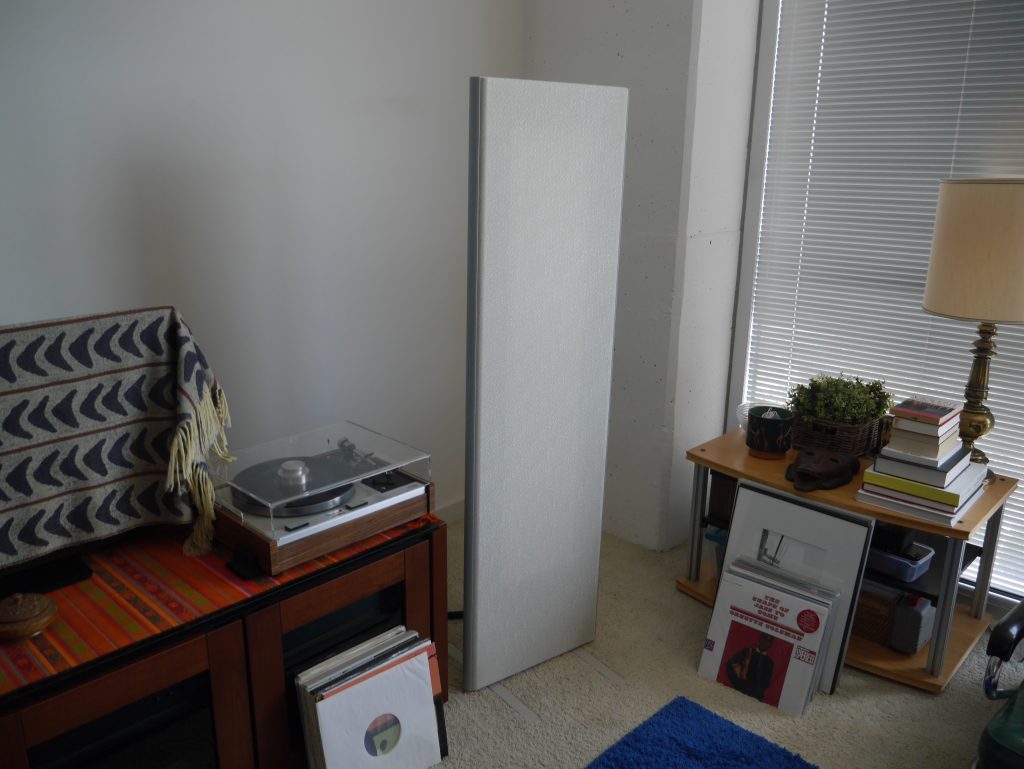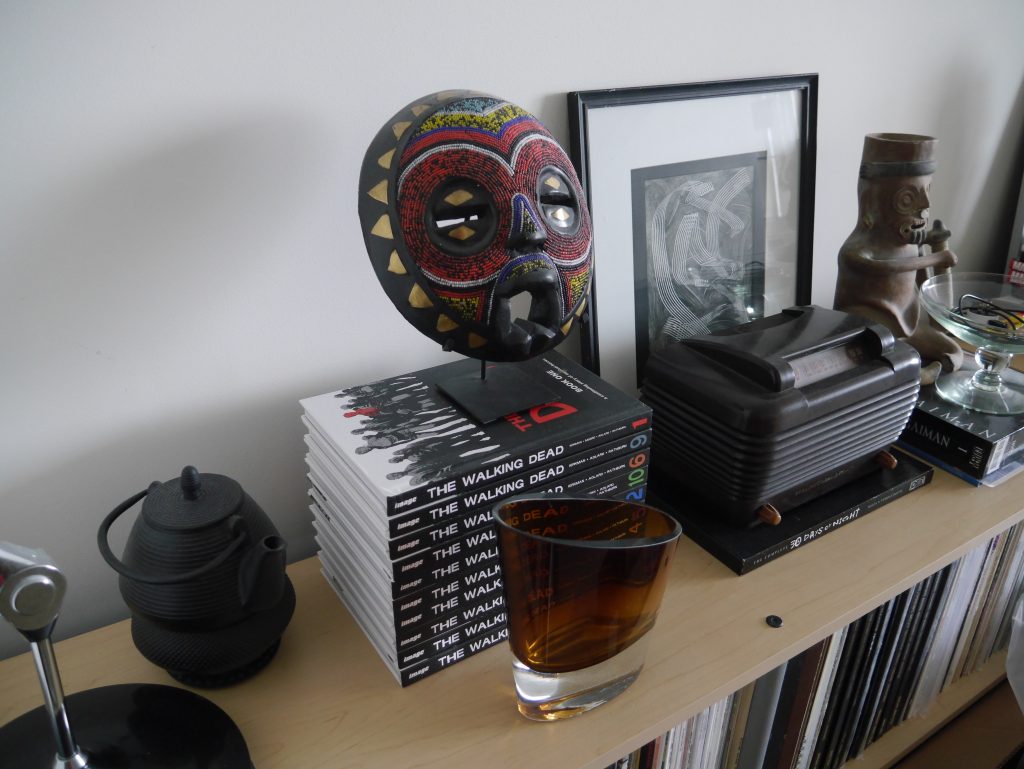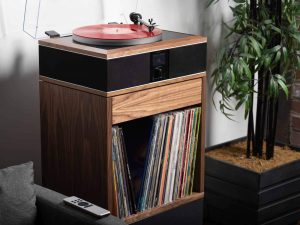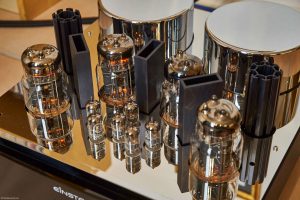Plus a Few Album Recommendations
Component Droughts, the Grumblings of Privileged Men, and Happy Endings
For longer than I care to remember, I don't have any components to review, a situation I find both annoying and liberating. Liberating in the sense that I needed a respite - as well as the kind of perspective that only distance and time can provide - following the conclusion of my reviewing duties at my former audio home, Stereo Times. Annoying in that I'm itching to insert some new gear into my system. Transitions always exact a cost, in this case, a minor hole in my reviewing schedule.
(Wouldn't you know it: just as I was set to wrap up this little project last night, in came a phone call from the condo concierge notifying me that a large UPS package from White Bear Lake, Minnesota had just arrived at the front desk. So much for my reviewing drought! It took me an hour to set up the Maggie 1.7is).
But, enough of my grumbling. This is supposed to be an introduction letter of sorts, a way to acquaint our readers with PF's newest reviewer, yours truly. So let's start with what really matters: the music. My love of music began, not surprisingly, at an early age. I came up at a time when music and arts instruction were staples of American public education. I gravitated toward the saxophone, first the alto, later the tenor. I briefly flirted with the monstrous baritone sax, but returned shortly thereafter to the tenor's familiar embrace (and occasionally the soprano, the hardest member of the sax family to master). I play a Selmer Mark VI, a mid-century icon of sorts, an instrument with a deep, burnished tone. Sadly, I never mastered the flute, a lifelong disappointment. My early musical diet consisted of wind ensemble works, light classical fare, and reinterpretations of pop standards. Jazz and more demanding classical forms followed later in life.
I had the good fortune to study music theory with Bill Lawing at Davidson College and the late Repard Stone at Howard University. I am privileged to count the great tenor saxophonist Tim Warfield as both classmate and friend, and am indebted to a long line of fine musicians for giving me the chance to study and play alongside them (including, believe it or not, a brief stint with the Macedonia Radio and Television Jazz Orchestra during an overseas posting with the Open Society).
I've also had the good fortune to call home two cities with great live performance traditions. In Cincinnati, this includes Music Hall and occasional visits to the Cincinnati Conservatory of Music (CCM). If you live in Cincinnati and love classical music, check out the CCM music schedule. You won't be disappointed (http://ccm.uc.edu/boxoffice/concerts.html). In Chicago, I spent more nights at Symphony Center than I care to remember, as well as many memorable trips to the campuses of Northwestern and the University of Chicago to take in probing student performances. Jazz outings at the Green Mill, Joel Segal's legendary Jazz Showcase, and the now sadly defunct New Apartment Lounge fill me with warm memories.
My musical tastes run the gamut. I consider myself a curious eccentric. I love twentieth century classical music, especially the works of Bartok, Lutoslawski, and Carter. I adore Bach and Mozart, too. Growing up in Cincinnati, Ohio meant frequent school trips to Music Hall to hear Tommy Shippers conducting the stalwart Cincinnatians (plus, Hudepohl beer, White Castle burgers, Skyline Chili, Graters Ice Cream and a deep and abiding affection for guy named Sparky).
Jazz, especially the freer forms that emerged in the late fifties onward, ranks highly in my aesthetic universe. Big band pioneers like Toshiko Akiyoshi, Mel Lewis, Thad Jones, Gerald Wilson and Maria Schneider are heroes and constant sources of inspiration and wonderment. Wayne Shorter's soaring, angular compositions have forever transformed how I listen to and hear music. Amazingly, I had the good fortune last week to hear the timeless Mr. Shorter improvising alongside the great Herbie Hancock at the Dr. Philips Performing Arts Center here in Orlando. At 82 and 76 respectively, these seasoned jazz luminaries still have what it takes to move and mesmerize. Color me impressed!
The Brazilian "Tropicália" movement captured my ear and my political imagination during my college days. My infatuation with this genre actually began during the height of the Free South Africa Movement courtesy of the eclectic programming at the once-great WPFW, arguably the greatest American jazz radio station of the 1970s and 80s. These sounds honed my deep appreciation for music's history and cultural context.
My Journey Toward the Dark Side
My first tentative steps into the high end took place under the tutelage of the late Marv Albitz, a family friend and close colleague of my father. I was eighteen. Marv was an audiophile of the Old Order. He built his own tube amps (back-breaking monstrosities the size of small refrigerators). He mounted arrays of ribbon drivers to the front wall of his listening room, and six twelve-inch Bozak woofers inside a reinforced closet adjacent to the listening room that functioned as the ultimate subwoofer. Source material consisted of LPs only. By today's standards, the sound Marv got was euphonically tinted and 'boomed' in the bass, but brother could his set-up rock (and move you both physically and emotionally). It was under Marv's guidance that I discovered J. Gordon Holt and Harry Pearson, and forever abandoned the measurement gurus in favor of the impressionists.
I have a fascination with all things analog, including new and vintage turntables, preferably suspended, although I remain open to persuasion on this point. I recently purchased a vintage Linn LP 12 that I am dying to refurbish (and to report on). On the other hand, I also look forward to investigating the single hottest product segment in the high-end, namely digital music server/renderers that do not require laptop computers to operate. To be sure, this newest generation of server/renderers are all merely specialized computers, but computers dedicated to a single purpose: playing back digital music files at the highest possible fidelity.
Companies like Lumin, Aurender, Melco, Baetis, and Bryston have altered fundamentally how audiophiles store and listen to their favorite digital recordings, with no signs of slowing progress. Interestingly, while many established marques have jumped head-first into this strange new world (think NAD, Meridian-Sooloos, Linn, Naim, etc.) a number of otherwise major players remain conspicuous by their absence. Firms like Musical Fidelity, Parasound, Pass Labs, Rogue, Audio Research, and a few others fall into this camp. There is good reason for their trepidation. As one well-respected manufacturer shared with me recently, the decision not to invest in silicon (slang for dedicated computer-based audio playback) is driven by steep initial R&D and tooling costs (which can run into the millions) and the fact that such investments will become obsolete in 18-24 months.
On the speaker front, I harbor an irrational love of expensive mini-monitors and, perhaps paradoxically, planar speakers. However, since I live in tight quarters (my listening room measures 16 x 13), speaker type and size matters. Having said that, my listening room has successfully accommodated, and to remarkable effect, the superb King Sound Prince III ESLs as well as the humbler PSB M2 Compact monitors. Preliminary indications suggest that the 1.7s also work well.
The Maggie 1.7is settling in
As for electronics, I am firmly a solid state kind-of-guy, but welcome the opportunity to learn more about tubes and tube designs. An overview of my current system appears below for those interested in such things.
Listening Priorities
More than anything, I seek out components that replicate as closely as possible the sound of the real thing. 'Real' for me refers to how easily a given component or system permits me to suspend disbelief, that is, to ignore to the extent possible the stacks of LPs, CDs, amps, turntables, wires, amps and speakers sitting in front of me and to lose myself in the music. The undeniable truth is that some systems do this better than others, price and measured performance considerations notwithstanding.
At AXPONA 2016, I heard a modest set-up that featured a $500 pair of mini-monitors driven by a collection of modestly priced digital components (including class D amps) that in terms of sheer realism, blew the socks off more than a few mega-buck systems. Yes, the bigger, pricier spreads played bigger, deeper, louder and more cleanly at higher SPLs, but if forced to choose between the various set-ups, I would invariably pick the economy system on sheer realism grounds. I'll have more to say on AXPONA 2016 in my upcoming PF show report.
Transparency, coherence, broad and deep sound-staging, solid imaging, and micro-dynamic nuance top my list of musical priorities, deep, bone-crushing bass dynamics less so. I do my best to avoid taking dogmatically rigid stances on such things as the purported musical superiority of tubes versus solid state (I have heard superb and miserable examples of both types of electronics), or arguing that one approach to obtaining great sound is inherently better than another (that unsuspended, high mass turntables always sound better than their suspended cousins, for example).
I love movies, am an unapologetic fan of the sci-fi and horror genres (and their novelistic counterparts), drink good wine regularly, workout several times a week, and try to avoid stressful situations as much as possible. Yeah, right! Politics intrigue me, as does modern African and European history. I hate cleaning LPs, but love the sound of great vinyl, which means that I have to clean my LPs regularly, my acknowledged dislike of the latter notwithstanding. Bigotry and intolerance are huge turn-offs, as is narrow-mindedness.
Random Tchotchkes
In Heavy Rotation
As noted earlier, my musical preferences tend to the eclectic. I listen to whatever strikes me at a given moment. Current vinyl crushes included the Columbia Legacy 180-gram mono reissues of some classic Miles Davis albums. Standouts include Kind of Blue (Columbia/Sony Legacy CL-1355 (88883761031)) and Someday My Prince Will Come (Columbia/Sony Legacy CL-1656 (88765486071)). Resonance Record's outstanding remastered release of organist Larry Young's stunning In Paris: The ORTF Recordings (Resonance Records HLP-9022), a lost two-LP gem from a series of live 1964 Paris broadcasts, are simply mesmerizing. Miss this release at your peril.
In the digital realm, the small but superb German Acousence Records label (https://www.acousence.de/) consistently produces some of the finest sounding classical recordings around. Acousense sells its small but rapidly growing classical catalogue across multiple formats: LP, CD, and high resolution 24Bit/96kHz and 24Bit/192kHz digital downloads. Atmospheric, airy and boasting a richly variegated tonal range, the ten or so Acousence CDs (and one LP) in my collection just sound right. So far, I've only found these superb discs on Amazon, but you can download the high resolution versions directly from High Res Audio (https://www.highresaudio.com/index.php) for about $15 a pop, a bargain if you ask me. Avoid these superb recordings at your peril.
Coming attractions
Despite the recent equipment drought here at casa Jeffries, the good news is that I have arranged, with the able assistance of our own Dr. David Robinson and Dave Clark, upcoming reviews of the new Lumin U1 music server/transport and the recently delivered Magneplanar 1.7is. My first encounter with the Maggie 1.7s dates back to a brief audition at a dealer's showroom about two years ago. What I heard during that brief listening session left me highly impressed and extremely curious to hear what these amazing panels would sound like in my room. A couple of email exchanges with the affable Wendell Diller at Maggie was all it took to set up delivery. Although the Maggies are still breaking in, they already show signs of greatness. Look for my enthusiastic preview shortly.
The very gracious and very talented Mark Williams, Silnote Audio's CEO and chief design engineer, has promised a set of his luxe Orion M1 interconnects. Mark is a real gentleman, a snappy dresser, and one very talented audio engineer. If the Silnote Audio name is new to you, I strongly encourage you to seek out the firm's fine sounding, fairly priced, hand-made products. Discussions are also underway to obtain some goodies I heard at AXPONA 2016, including the stunning EnigmAcoustics Mythology M1 compacts, the outstanding and brand-spanking new Bryston 4B3 stereo power amp, and perhaps one of the fine mid-level Acoustic Signature turntables, distributed stateside by the good folks at Fidelis AV.
As for the Lumin U1, a brief listening session at AXPONA in the Source Systems, Ltd. room (ably manned by the gracious Mark Gurvey) left me with the impression, in musical terms, that Lumin brings to the table many of the same qualities as the superb Aurender servers. On a personal level, I happen to be on the lookout for a plug-and-play digital server/DAC playback system to replace my home brew computer-based system. Although my Dell laptop/JRiver 19/TEAC UD-H01 USB DAC setup delivers decent sound, I am not at all a fan of the frequent electronic pops and ticks that accompany digital replay via the Dell. Nor am I a fan of JRiver's software, despite its capacity to deliver excellent sound in a properly configured system. Why? Not to put too sharp a point on things, but I find JRiver to be a royal pain in the ass to use. Yes, JRiver's architecture is extremely flexible and affords users a high degree of control when configuring their computer-based (or Baetis Music Server) systems, but I find the system difficult to navigate, generally counter-intuitive in overall use, and cumbersome.
Please note that I am not criticizing in any way JRiver's sound quality, which I find first-rate. Rather, I am of the mind that JRiver is best suited to computer users who don't mind configuring their playback software to meet their particular storage and playback needs. I want something a bit more plug-and-play simple. What I have seen (and heard) from the likes of Lumin, Aurender and Sony (the HAP-Z1ES) suggests that music lovers with large digital files (my current downloaded library contains over 2 TBs of material) no longer need to sacrifice playback fidelity and musicality for ease of use.
Obviously, the Lumin represents merely the tip of the digital iceberg. At the urging of David and Dave, I'll hopefully get the chance to listen to several more servers (arguably the single hottest segment in the high end component universe) and a number of affordable DACs as well.
So, there you have it: just over half a century's worth of listening biases, preferences, perceptions and misconceptions all reduced to about 2,600 words. It goes without saying that I welcome all comments, constructive criticisms, tax-free donations, and insightful music tips.
Good listening!
Review system
- Digital sources: Marantz SA-15S2 Limited Edition SACD/CD Player; TEAC UD-H01 USB DAC
- Music software: JRiver Media; iTunes
- Analogue source: Vinyl Nirvana refurbished Thorens TD 125 MkII turntable; SME M2-9 tone-arm; Dynavector DV-20X2 low output mc cartridge
- Preamps: Parasound JC-2 line-stage; Parasound JC-3+ phono preamp; Pro-ject Phono-Box RS
- Power amp: Cambridge Audio 840W
- Speakers: Magneplanar 1.7is; PSB M2 compact monitors (on dedicated stands)
- Cables: Soundstring interconnect and power cables; Silnote Poseidon Signature interconnect cables (XLR terminated); Silnote Orion M2 speaker cables
- Accessories: Funk Firm Achromat (3mm version); Vinyl Nirvana cork-rubber composite mat; Bren record weight; Salamander Corsica 237 AV cabinet








































